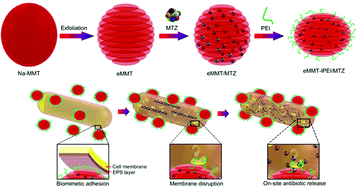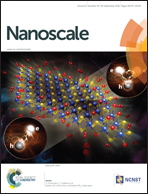Engineering bioinspired bacteria-adhesive clay nanoparticles with a membrane-disruptive property for the treatment of Helicobacter pylori infection†
Abstract
We present a bioinspired design strategy to engineer bacteria-targeting and membrane-disruptive nanoparticles for the effective antibiotic therapy of Helicobacter pylori (H. pylori) infection. Antibacterial nanoparticles were self-assembled from highly exfoliated montmorillonite (eMMT) and cationic linear polyethyleneimine (lPEI) via electrostatic interactions. eMMT functions as a bioinspired ‘sticky’ building block for anchoring antibacterial nanoparticles onto the bacterial cell surface via bacteria-secreted extracellular polymeric substances (EPS), whereas membrane-disruptive lPEI is able to efficiently lyse the bacterial outer membrane to allow topical transmembrane delivery of antibiotics into the intracellular cytoplasm. As a result, eMMT-lPEI nanoparticles intercalated with the antibiotic metronidazole (MTZ) not only efficiently target bacteria via EPS-mediated adhesion and kill bacteria in vitro, but also can effectively remain in the stomach where H. pylori reside, thereby serving as an efficient drug carrier for the direct on-site release of MTZ into the bacterial cytoplasm. Importantly, MTZ-intercalated eMMT-lPEI nanoparticles were able to efficiently eradicate H. pylori in vivo and to significantly improve H. pylori-associated gastric ulcers and the inflammatory response in a mouse model, and also showed superior therapeutic efficacy as compared to standard triple therapy. Our findings reveal that bacterial adhesion plays a critical role in promoting efficient antimicrobial delivery and also represent an original bioinspired targeting strategy via specific EPS-mediated adsorption. The bacteria-adhesive eMMT-lPEI nanoparticles with membrane-disruptive ability may constitute a promising drug carrier system for the efficacious targeted delivery of antibiotics in the treatment of bacterial infections.



 Please wait while we load your content...
Please wait while we load your content...